| Frequently Asked QuestionsCommon Vision-related TermsRefractive ErrorThis term describes a mismatch among the refractive elements of the eye while accommodation is at rest. This mismatch results in blur as it does not allow a sharp image to fall on the retina or light sensitive layer of the eye. The refractive elements include the corneal curvatures, lenticular curvatures, axial length, respective indexes, thicknesses and retinal curvature. In short, there is no disease process here, but just a blurred image because the combination of these elements makes the total optical system out of focus. 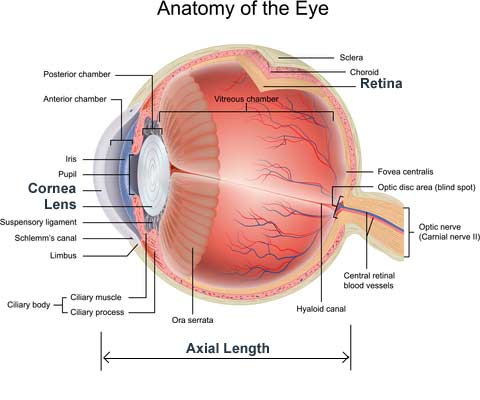 If all of the refractive elements are balanced appropriately, then we have a condition called emmetropia or no refractive error. Emmetropia
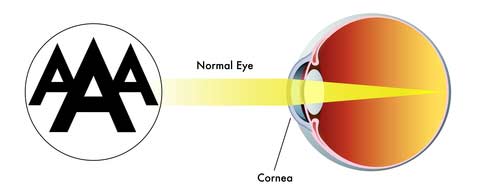 Various Refractive ErrorsMyopia
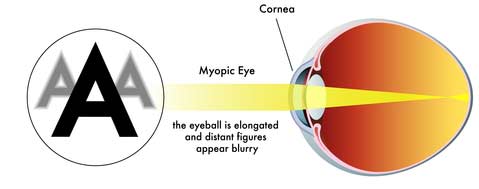 Hyperopia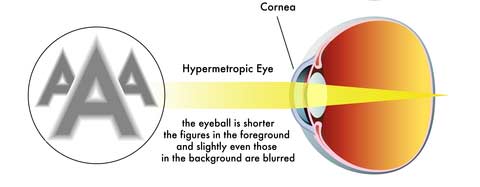 A condition where light rays from the distance would theoretically be focused at some point behind the retina. Astigmatism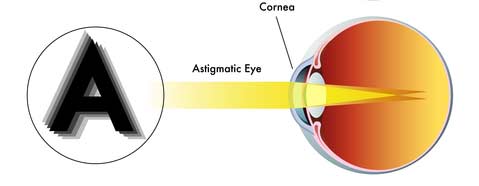 A condition where light rays from the distance are split into two different points. There are various types of astigmatism. In any of the above conditions, the closer the focused image is to the retina, the sharper the image may be perceived. Treatment for refractive error usually involves the use of corrective lenses. These corrective lenses typically take the form of spectacle lenses or contact lenses. An additional option is to consider refractive surgery. Refractive SurgeryThere are many types of refractive surgery and the advantage or disadvantage of each needs to be evaluated for every candidate. Typically, the procedure takes your current distance spectacle correction and sculpts that correction into your cornea. The vast majority of people are very happy with their visual outcome and enjoy the freedom they gain from the dependence on glasses or contact lenses to see. It needs to be kept in mind that the crystalline lens inside your eye is continually growing. This process will continue after your refractive surgery and may require you to consider eyeglasses, contact lenses and/or another refractive surgery down the road. While no one can predict how long that would be, hopefully it is 7-10 years or more. Additionally, how free you are from glasses or contact lenses needs to be kept in the context of how close you are to presbyopia. Presbyopia usually affects us about the age of 40 when we start to need corrective lenses to read up close. There are many things that need to be discussed with the particular procedure selected for you. Typically, if your expectations meet what the procedure can provide, everybody is happy. Spectacle PrescriptionsCommonly, spectacle prescriptions are written with the following characteristics and meanings: 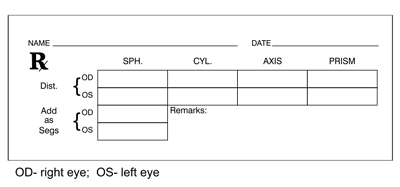 Dist: This corresponds to your distance visual correction. The first blank corresponds to the correction of myopia or hyperopia. The second and third blanks correspond to correcting the presence of any astigmatism. The second blank relates to the amount of cylinder needed and the third blank to its axis or location within the lens. Add as Segs: This describes the amount of lens power needed to help for any accommodative related deficiency. Prism: This displaces the direction of light but does not alter its power. It is used to help eliminate double vision and or make your eyes feel comfortable. Accommodation or Focusing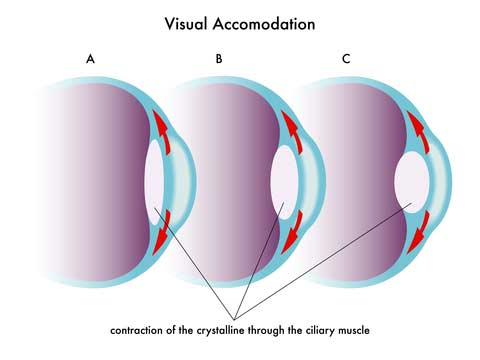 This is the process by which the ciliary muscle within the eye constricts, allowing the lens to bulge forward, increasing its curvature and center thickness. It is this change that will take near objects and bring them into focus on the retina. Presbyopia-Loss of Near Vision with Age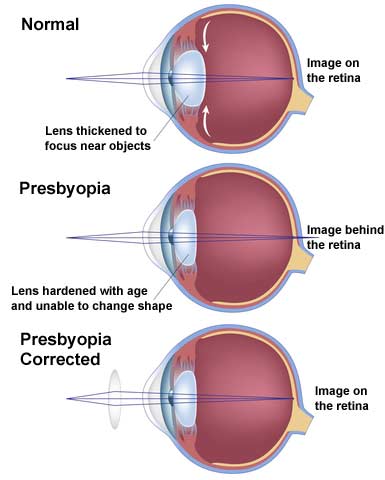
This term describes the gradual and slowly progressive loss of accommodation that we all experience. This loss is usually noticed about the age of forty, as it becomes increasingly difficult to read small print at near. It is generally held that this loss of focusing is due to a thicker and less flexible lens. From the day we are born, the lens inside our eye is constantly growing thicker. It does this similar to a tree, in that the lens fibers toward the center are dead and only those near the front surface are alive. Treatment usually requires the use of lenses designed to compensate for the loss of accommodation. Commonly, these take the form of spectacle lenses designed as single vision reading glasses, bifocal, trifocal or progressives. Relative to contact lenses the correction may also take the form of bifocal, trifocal or progressive lenses. However, in this modality the success rate is more limited because of all the factors involved in fitting the lens. The vast majority of patients that wear contact lenses over the age of 40, wear one lens fit for the distance and the other fit for near (mono-vision) or they wear contacts fit for the distance in each eye and put on reading glasses over the contacts to see at near. For those of us with presbyopia, current refractive surgery is limited to correcting both eyes for the distance with concurrent use of reading glasses or surgically inducing mono-vision by correcting one eye for the distance the other for near. As we approach the age of 50, more patients that do a lot of near paperwork and or computer work find that their mono-vision set up or regular glasses do not work as well as it did in the past. The continual loss of accommodation and nature of near work leads to frustration up close. In this situation, it is not uncommon for a patient to wear a specific pair of glasses, different from their everyday pair or over their mono-vision set up that is specifically designed to eliminate the frustration. Presently, these are the common corrective modalities for presbyopia. However, research is being done to surgically correct presbyopia. These methods include scleral expansion bands, anterior ciliary sclerotomy and laser reversal to allow for scleral expansion. The data on these methods is not yet conclusive and none have been given approval by the FDA. Why Your Pupils Are Dilated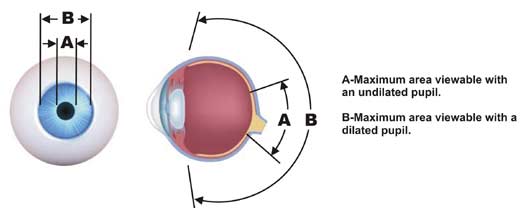 Your pupils are routinely dilated for two main reasons: The first is to allow for as clear and unobstructed a view of the interior of your eye as possible. This becomes even more important as we grow older developing cataracts, vitreous haze and our pupils become smaller in size. The second is to allow for the viewing of more area inside the eye. With an undilated pupil, the amount of area possible to view is significantly reduced compared to the area with a dilated pupil. This is important in assessing for many conditions including tumors, inflammations and retinal degenerations that may go unobserved with an undilated pupil. Tips on Caring for your Glasses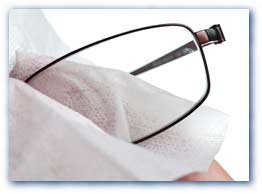
Tap water and mild liquid dishwashing soap do a very good job on cleaning your lenses. Specially prepared optical cleaners will also suffice. Cleaners like Windex that contain ammonia can damage coatings on lenses. The key to proper lens care is to make sure they are rinsed thoroughly with water prior to applying any cleaner. Neither glass nor plastic lenses should be wiped when they are dry; rinse them off first! A 100% cotton towel or optical micro-fiber cloth is recommended for drying your lenses. Do not use paper towels, tissues or napkins; as they will scratch your lenses over time. Place your glasses into their case when not being used. This is increasingly important if the glasses are repeatedly being put into purses or pockets. Never place your lenses face down on a hard surface. Do not leave your eyeglasses on the dash of your car, the excessive heat can loosen the fitting characteristics of the frame and may cause crazing of your spectacle lenses. 
Remove and place the glasses on with both hands. If you continually remove the glasses with one hand, your frame will frequently need to be adjusted. Additionally, the frame many not last a long with this improper handling. With use, frames start to lose their original fitting characteristics. When your frame seems too loose, crooked, skewed or uncomfortable, they probably need to be realigned for proper fitting. Copyright © 2013-2023 by Brian Van Dusen, O.D. and CitiVU. Hot-links are welcome. All rights reserved. Some images © Skypixel, Rob3000, Nguyet M Le, Alexandr Mitiuc, Steveheap, & Peter Junaidy | Dreamstime.com Last Change: 4 December, 2013 | |||||||||||||||||||||||||||||||||||||||||||||||||||||||||||||||||||||||